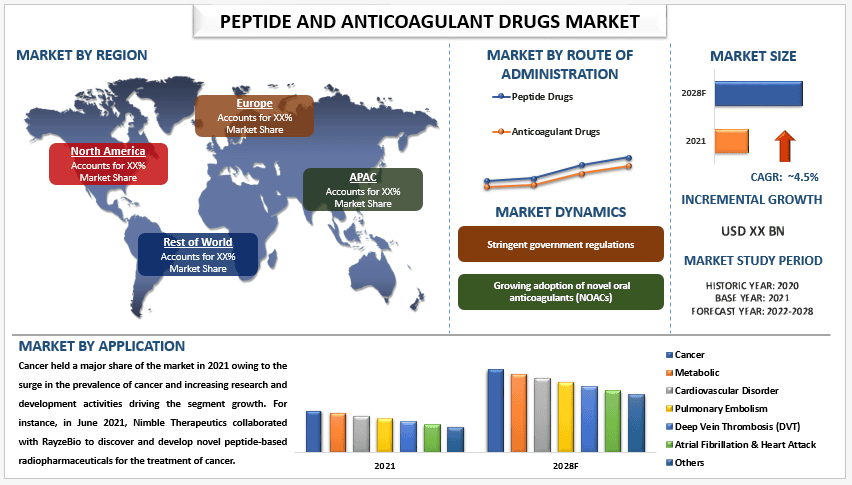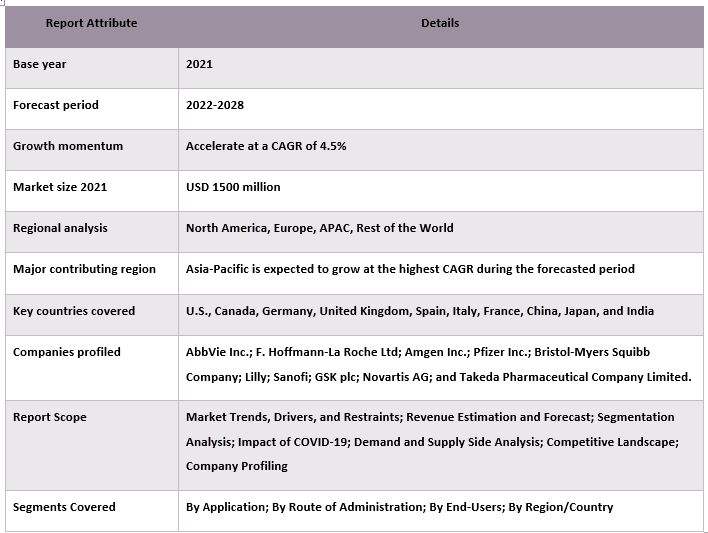
펩타이드 및 항응고제 시장은 2021년에 15억 달러로 평가되었으며 암 발생률 증가, 다양한 심혈관 질환 유병률 증가, 새로운 펩타이드 치료제 개발을 위한 연구 개발 활동 증가, 새로운 약물 파이프라인 개발로 인해 예측 기간(2022-2030) 동안 약 4.5%의 강력한 CAGR로 성장할 것으로 예상됩니다. 더욱이 세계 보건 기구(WHO)에 따르면 당뇨병 및 심혈관 질환과 같은 만성 질환은 전 세계적으로 주요한 이환율 및 사망 원인입니다. 만성 질환 발생률은 전 세계적으로 급증하여 모든 지역에서 발전하고 모든 사회 경제적 계층에 영향을 미치고 있습니다. 만성 질환은 2020년에 전체 사망의 73%, 전 세계 질병 부담의 60%를 유발한 것으로 추정되었습니다. 결과적으로 만성 질환의 유병률 증가는 효과적인 치료제에 대한 수요를 증가시켜 시장을 주도할 것으로 예상됩니다. 더욱이 이는 전 세계적으로 심방세동 및 심장 마비 환자 수의 급증과 함께 시장을 주도하고 있습니다. 미국 질병통제예방센터에 따르면 2030년까지 미국에서 약 1,210만 명이 심방세동을 앓게 될 것입니다. 2019년에는 26,535명이 심방세동으로 사망한 것으로 보고되었습니다. 또한 2019년에는 1,790만 명이 심혈관 질환으로 사망했습니다. 세계 보건 기구에 따르면 이러한 사망 중 85%는 심장 마비와 뇌졸중으로 인한 것입니다. 또한 암과 같은 만성 질환 치료를 위한 새로운 펩타이드 치료제의 기술 개발 및 도입도 연구된 시장의 성장을 촉진하고 있습니다. 예를 들어 2021년 5월 ISSAR Pharmaceuticals는 pre-IND 신청으로 펩타이드 기반 신규 NCE를 라이선스하기로 결정했습니다. 따라서 위에서 언급한 요인들이 향후 시장 성장을 주도하고 있습니다.
시장에서 활동하는 주요 업체로는 AbbVie Inc., F. Hoffmann-La Roche Ltd, Amgen Inc., Pfizer Inc., Bristol-Myers Squibb Company, Lilly, Sanofi, GSK plc, Novartis AG, Takeda Pharmaceutical Company Limited 등이 있습니다. 이러한 업체들은 고객에게 하이테크 및 혁신적인 제품/기술을 제공하기 위해 여러 M&A와 파트너십을 체결했습니다.
보고서에 제시된 인사이트
"응용 분야 중 대사 부문이 2021년 시장에서 상당한 점유율을 차지했습니다."
응용 분야에 따라 시장은 암, 대사, 심혈관 질환, 폐색전증, 심부 정맥 혈전증, 심방세동 및 심장 마비 등으로 세분화됩니다. 당사 분석에 따르면 대사 부문이 2021년 시장에서 상당한 점유율을 차지했습니다. 노인 인구 증가와 관련된 대사 장애 유병률 급증은 부문 성장에 기여하는 주요 요인입니다. 고셔병(GD)은 뼈, 골수, 간 및 비장에 주로 존재하는 대식세포에 점진적인 글루코세레브로시드 저장을 특징으로 하는 상염색체 열성 리소좀 저장 장애입니다. 2022년 7월 JPHO 저널에 게재된 기사에 따르면 전 세계 출생에서 GD의 유병률은 100,000명의 출생아당 1.5건이었습니다. GD의 전체적인 세계 유병률은 인구 100,000명당 0.9건이었습니다. 이러한 대사 장애의 높은 유병률은 대사 장애 치료를 위한 펩타이드 치료제에 대한 수요를 촉진하여 연구된 시장의 성장을 주도하고 있습니다.
"기술 중 주사제 부문은 예측 기간 동안 상당한 CAGR로 성장할 것으로 예상됩니다."
투여 경로별로 시장은 펩타이드 약물(피하, 점막, 경구 및 경피로 세분화됨)과 항응고제 약물(경구 및 주사제로 세분화됨)로 세분화됩니다. 이 중 주사제 부문은 예측 기간 동안 상당한 CAGR로 성장할 것으로 예상됩니다. 이 부문의 성장은 현재 더 많은 환자가 주사 가능한 항응고제를 선호하기 때문입니다. 일반적으로 사용되는 주사 가능한 항응고제로는 저분자량 헤파린, 레피루딘, 다나파로이드 등이 있습니다. 그러나 경구 부문도 예측 기간 동안 수익성 있는 CAGR로 성장할 것으로 예상됩니다.
"APAC는 예측 기간 동안 높은 CAGR로 성장할 것입니다."
APAC는 미개척 기회, 원자재 저렴한 비용, 아웃소싱 서비스를 제공하는 많은 회사, 번성하는 생명 공학 산업, 증가하는 연구 개발 활동으로 인해 예측 기간 동안 상당한 CAGR로 성장할 것으로 예상됩니다. 예를 들어 2022년 12월 PeptiDream은 새로운 펩타이드 약물 접합체 발견을 위해 Eli Lilly와 협력한다고 발표했습니다. 계약에 따라 PeptiDream은 Merck가 관심을 갖는 표적에 대한 PDC로 사용하기 위해 PeptiDream의 독점적인 펩타이드 발견 플랫폼 시스템(PDPS) 기술에서 확인된 펩타이드 후보를 제공할 것입니다. 더욱이 심혈관 질환 유병률 증가, 항응고 요법의 이점에 대한 인식 및 이해도 증가, 고령화 인구는 아시아 태평양 지역을 주도할 것입니다.
펩타이드 및 항응고제 시장 보고서 범위

이 보고서를 구매해야 하는 이유:
- 이 연구에는 인증된 주요 업계 전문가가 검증한 시장 규모 측정 및 예측 분석이 포함되어 있습니다.
- 이 보고서는 전체 산업 성과에 대한 빠른 검토를 한눈에 제공합니다.
- 이 보고서는 주요 비즈니스 재무, 제품 포트폴리오, 확장 전략 및 최근 개발에 중점을 두고 주요 산업 동료에 대한 심층 분석을 다룹니다.
- 산업에서 널리 퍼져있는 동인, 제약, 주요 트렌드 및 기회에 대한 자세한 검토.
- 이 연구는 다양한 부문에 걸쳐 시장을 포괄적으로 다룹니다.
- 산업에 대한 심층적인 지역 수준 분석.
맞춤화 옵션:
글로벌 펩타이드 및 항응고제 시장은 요구 사항 또는 기타 시장 부문에 따라 추가로 맞춤화할 수 있습니다. 이 외에도 UMI는 귀하가 고유한 비즈니스 요구 사항을 가지고 있음을 이해하므로 귀하의 요구 사항에 완벽하게 맞는 보고서를 얻기 위해 저희에게 자유롭게 연락하십시오.
목차
펩타이드 및 항응고제 시장 분석 (2022-2028)을 위한 연구 방법론
글로벌 펩타이드 및 항응고제 시장의 과거 시장 분석, 현재 시장 추정 및 미래 시장 예측은 주요 지역에서 펩타이드 및 항응고제의 도입을 분석하고 연구하기 위해 수행된 세 가지 주요 단계입니다. 과거 시장 수치를 수집하고 현재 시장 규모를 추정하기 위해 광범위한 2차 연구가 수행되었습니다. 둘째, 이러한 통찰력을 검증하기 위해 수많은 조사 결과와 가정이 고려되었습니다. 또한, 글로벌 펩타이드 및 항응고제 시장의 가치 사슬 전반에 걸쳐 업계 전문가와 함께 광범위한 1차 인터뷰도 수행되었습니다. 1차 인터뷰를 통해 시장 수치를 가정하고 검증한 후, 전체 시장 규모를 예측하기 위해 하향식/상향식 접근 방식을 사용했습니다. 그 후, 시장 세분화 및 데이터 삼각 측량 방법을 채택하여 업계 관련 세그먼트 및 하위 세그먼트의 시장 규모를 추정하고 분석했습니다. 자세한 방법론은 아래에 설명되어 있습니다.
과거 시장 규모 분석
1단계: 2차 출처에 대한 심층 연구:
연간 보고서 및 재무제표, 실적 발표, 보도 자료 등과 같은 회사 내부 자료와 저널, 뉴스 및 기사, 정부 간행물, 경쟁사 간행물, 부문 보고서, 타사 데이터베이스 및 기타 신뢰할 수 있는 간행물을 포함한 외부 자료를 통해 펩타이드 및 항응고제 시장의 과거 시장 규모를 확보하기 위해 자세한 2차 연구가 수행되었습니다.
2단계: 시장 세분화:
펩타이드 및 항응고제 시장의 과거 시장 규모를 확보한 후, 주요 지역에 대한 다양한 세그먼트 및 하위 세그먼트에 대한 과거 시장 통찰력과 점유율을 수집하기 위해 자세한 2차 분석을 수행했습니다. 주요 세그먼트는 보고서에 애플리케이션, 투여 경로 및 유통 채널로 포함되어 있습니다. 또한 해당 지역에서 테스트 모델의 전반적인 도입을 평가하기 위해 국가 수준 분석이 수행되었습니다.
3단계: 요인 분석:
다양한 세그먼트 및 하위 세그먼트의 과거 시장 규모를 확보한 후, 펩타이드 및 항응고제 시장의 현재 시장 규모를 추정하기 위해 자세한 요인 분석을 수행했습니다. 또한 펩타이드 및 항응고제 시장의 애플리케이션, 투여 경로 및 유통 채널과 같은 종속 및 독립 변수를 사용하여 요인 분석을 수행했습니다. 전 세계 펩타이드 및 항응고제 시장 부문에서 최고의 파트너십, 합병 및 인수, 사업 확장 및 제품 출시를 고려하여 수요 및 공급 측면 시나리오에 대한 철저한 분석이 수행되었습니다.
현재 시장 규모 추정 및 예측
현재 시장 규모 측정: 위의 3단계에서 얻은 실행 가능한 통찰력을 바탕으로, 현재 시장 규모, 글로벌 펩타이드 및 항응고제 시장의 주요 업체 및 세그먼트의 시장 점유율을 파악했습니다. 필요한 모든 비율 점유율 분할 및 시장 세분화는 위에서 언급한 2차 접근 방식을 사용하여 결정되었으며 1차 인터뷰를 통해 검증되었습니다.
추정 및 예측: 시장 추정 및 예측을 위해 이해 관계자가 사용할 수 있는 동인 및 추세, 제약 조건 및 기회를 포함한 다양한 요인에 가중치가 할당되었습니다. 이러한 요인을 분석한 후, 관련 예측 기술, 즉 하향식/상향식 접근 방식을 적용하여 전 세계 주요 시장에서 다양한 세그먼트 및 하위 세그먼트에 대한 2028년 시장 예측을 도출했습니다. 시장 규모를 추정하기 위해 채택된 연구 방법론은 다음과 같습니다.
- 수익(USD) 측면에서 업계의 시장 규모와 국내 주요 시장 전반에 걸친 펩타이드 및 항응고제 시장의 도입률
- 시장 세그먼트 및 하위 세그먼트의 모든 비율 점유율, 분할 및 세분화
- 제공되는 제품 측면에서 글로벌 펩타이드 및 항응고제 시장의 주요 업체. 또한 빠르게 성장하는 시장에서 경쟁하기 위해 이러한 업체가 채택한 성장 전략
시장 규모 및 점유율 검증
1차 연구: 주요 지역 전반에 걸쳐 최고 경영진(CXO/VP, 영업 책임자, 마케팅 책임자, 운영 책임자, 지역 책임자, 국가 책임자 등)을 포함한 핵심 오피니언 리더(KOL)와 심층 인터뷰를 수행했습니다. 그런 다음 1차 연구 결과를 요약하고 통계 분석을 수행하여 명시된 가설을 입증했습니다. 1차 연구의 입력은 2차 결과와 통합되어 정보를 실행 가능한 통찰력으로 전환했습니다.
다양한 지역의 1차 참가자 분할

시장 엔지니어링
데이터 삼각 측량 기술을 사용하여 전체 시장 추정을 완료하고 글로벌 펩타이드 및 항응고제 시장의 각 세그먼트 및 하위 세그먼트에 대한 정확한 통계 수치를 도출했습니다. 데이터는 글로벌 펩타이드 및 항응고제 시장에서 애플리케이션, 투여 경로 및 유통 채널 영역의 다양한 매개변수와 추세를 연구한 후 여러 세그먼트 및 하위 세그먼트로 분할되었습니다.
글로벌 펩타이드 및 항응고제 시장 연구의 주요 목표
글로벌 펩타이드 및 항응고제 시장의 현재 및 미래 시장 동향이 연구에서 정확히 지적되었습니다. 투자자는 연구에서 수행된 질적 및 양적 분석을 바탕으로 투자에 대한 재량을 기반으로 전략적 통찰력을 얻을 수 있습니다. 현재 및 미래 시장 동향은 지역 수준에서 시장의 전반적인 매력을 결정하여 산업 참가자가 미개척 시장을 활용하여 선점자 이점을 얻을 수 있는 플랫폼을 제공했습니다. 연구의 다른 양적 목표는 다음과 같습니다.
- 가치(USD) 측면에서 펩타이드 및 항응고제 시장의 현재 및 예측 시장 규모를 분석합니다. 또한 다양한 세그먼트 및 하위 세그먼트의 현재 및 예측 시장 규모를 분석합니다.
- 연구의 세그먼트에는 애플리케이션, 투여 경로, 유통 채널 영역이 포함됩니다.
- 펩타이드 및 항응고제 산업에 대한 규제 프레임워크 정의 및 분석
- 다양한 중개자의 존재와 관련된 가치 사슬을 분석하고 산업의 고객 및 경쟁자 행동을 분석합니다.
- 주요 지역에 대한 펩타이드 및 항응고제 시장의 현재 및 예측 시장 규모를 분석합니다.
- 보고서에서 연구된 지역의 주요 국가에는 아시아 태평양, 유럽, 북미 및 기타 지역이 포함됩니다.
- 펩타이드 및 항응고제 시장의 회사 프로필과 빠르게 성장하는 시장에서 생존하기 위해 시장 참여자가 채택한 성장 전략
- 산업에 대한 심층적인 지역 수준 분석
관련 보고서
이 상품을 구매한 고객님들도 함께 구매하신 상품










